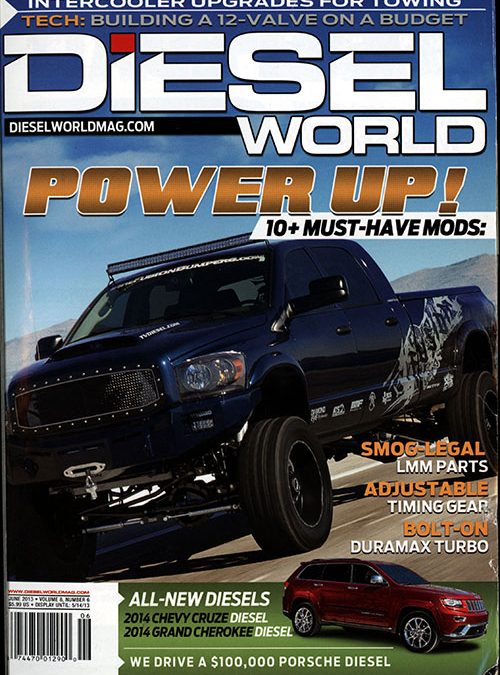The Science of Intercoolers
Diesel World June 2013
Intercoolers have been around for a long time. In automotive and aircraft use, they’re used to reduce the intake charge temperature on turbocharged and supercharged engines. The diesel using community is more familiar with turbochargers and intercoolers than the gas community as a whole. Turbochargers use the (usually wasted) energy of your exhaust to spin a turbo wheel and compress the air intake charge. The trouble is compressing something, even air, creates heat. Adding to this is the heat of the exhaust gas used to spin a turbocharger. This also imparts heat to the intake charge. Of course, as the air-fuel charge heats, it expands and becomes less dense.
The reason for an intercooler is to increase the intake air charge density. Simply put, cold air is denser and has more oxygen by volume. The more oxygen you can introduce, the more fuel you can burn, and the more complete the bum. The end result is more power to the wheels with less fuel use, or more power with the introduction of more fuel. Without an intercooler, the gains from a turbocharger are offset by the intake charge temperature increase, resulting in a zero sum gain.
The most common type of intercooler is the air-to-air intercooler. These are the typical type of intercoolers found mounted behind the grille and in front of the radiator on most diesel trucks. An air-to-air intercooler reduces the intake air charge in two ways. The first of these is simply by heat rejection caused by passing the intake charge through fins. The heat is transferred to the aluminum fin passages and from there to the ambient air passing through the grille. The second way heat is eliminated is through thermal expansion. Just as the intake charge heats on compression, it cools as it expands to fill the larger volume of the intercooler. A properly designed intercooler system will ensure that the decrease in temperature is greater than the drop in pressure, so that you have a net gain that results in a denser charge to the cylinders than without the turbo. The more efficient this process is, the more power you can make for a given amount of fuel. The design of an air-to-air intercooler is a delicate balance between size constraints, pressure drop, temperature reduction, core efficiency and, of course, cost. If an intercooler core is too thick, or dense, it will restrict airflow through the radiator core.
This can rest in higher engine operating temperatures and possible de-fueling of the engine by the ECU to prevent engine damage. In addition, inefficient core and end tank designs can result in turbulent and restricted airflow across the intercooler core. The result is more pressure drop at the intake side of the system. The other issue is that a very poor design can mean uneven airflow. In this case, the airflow is such that the air charge is not cooled as much as with an efficient core and the intake charge is hotter than need be. The last item to check when purchasing an aftermarket intercooler is the side tank strength. Thin side tank materials and/or a lack of bracing rods can be a nightmare for high boost systems. Larger turbos, and double or triple setups, mean higher boost pressures and a need for top quality intercoolers. If your intercooler is not up to the higher pressure, you could have core and/or side tank matures. Here at DW, we’ve seen this on race rigs with multiple turbo setups.
On the racing side, we sometimes see air-to-liquid intercoolers. In these systems excess heat is transferred from the intake charge to a fluid, usually water. This can be done with a tank of water, or a radiator on the output side of the liquid transfer to dump the heat from the air. On large stationary engines, this is practical, but on trucks and cars, the space and weight can be an issue. We’ve seen some race trucks that use the simpler, tank-only systems. But these tanks are drained and refilled with cool water after each pass down the drag strip. Some setups even have reservoirs that can have ice put into them for intake temperatures lower than ambient air.
We’ve also seen some air-to-air setups on the track that spray a mist of water onto the intercooler while running the lights, but many tracks discourage this as water on the track is not allowed due to safety concerns.
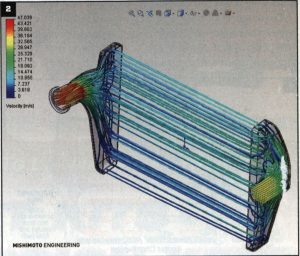
This Illustration from Mishimoto shows flow across a well-designed intercooler. You’ll notice that the fuel-air-charge comes in at a high pressure and drops as it crosses the core. The two key things are that the pressure across the core is even at all points and that the pressure at the exit point rises to almost the same as at the entry with a lower output temp.
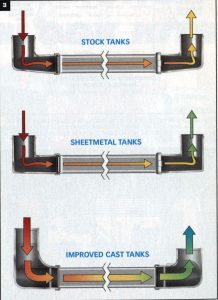
This line drawing from Banks Power shows how side tank design can affect the How across an Intercooler. The more restrictive the tanks are, the lower the flow across the core. Small differences in design can mean big differences in flow. The less restrictive and more efficient an intercoolers is, the better the end result.
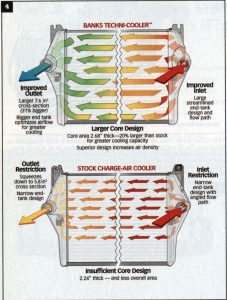
Also from Banks Power, this drawing compares a stuck charge air (intercooler) to a more efficient aftermarket one. The end result of a good aftermarket intercooler will be more airflow, higher temperature drop.
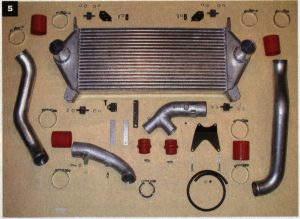
This intercooler kit for a Ford 7.31 is from Hypermax. When selecting your Intercooler, always check to see what comes with in and what doesn’t. Quality is your top priority, but don’t forget the total package cost when making your decision.
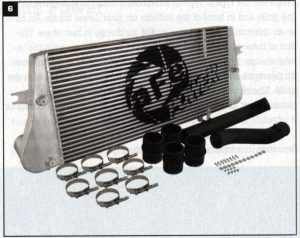
aFe Power offers the “BladeRunner” Intercooler for 1994-oz Dodge LS 5.3L diesel trucks. This intercooler utilizes a 3-inch bar and plate design that’s 37 percent larger than stock and outflows OE-style tube and fin core designs by 31 percent. The BladeRunner end tanks are constructed of 3/16-inch TIG welded aluminum plate tanks that incorporate three multi-directional vanes that ere said to direct hot air through the entire Intercooler core. It also features 3-inch inlet/outlet connections mated to oversized boost tubes that are included in the kit. Finally, it’s test pressure rated at 200 psi for use in high-boost applications.
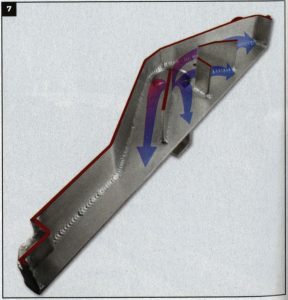
Here you see a cutaway of the multidirectional vanes in the input side tank that are said to direct hot air through the entire intercooler core.
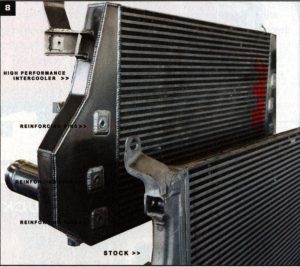
Here we see a PPE intercooler for GM ticks compared to the stock unit. The PPE cooler has pins welded into the side tanks to reinforce the cooler tanks for high-boost applications. PPE claims a 98-percent Increase in volume over stock as well as added strength.
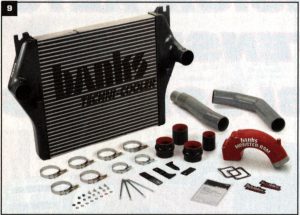
This Dodge intercooler kit from Banks Power includes their Monster-Ram intake. The increased boost from an upgraded intercooler can be reduced if the stock manifold intake is restrictive.
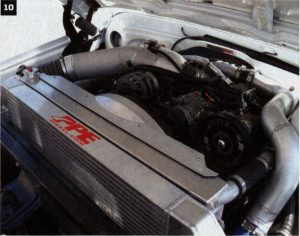
This shot of a PPE Intercooler in a Duramax truck shows that a larger intercooler can fit like stock, yet cool your truck like no stock intercooler can.
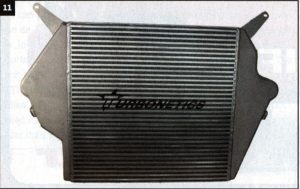
Here you see a performance cooler from Turbonetics. They offer a large line of intercoolers for everything from trucks to tractors and stationary engines. Ae the name implies, the company also has turbos, but thane for another story.
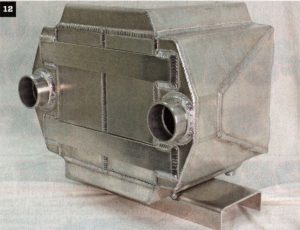
The other option in intercooler is the air-to-water, or liquid, unit like this one from Turbonetlcs. In race applications, this system can offer more cooling than an air-to-air cooler. The heat transfer is better and yours not restricted by ambient air temperatures. The downside is added weight, plumbing and the need to drain and refill the tank for every pass down the track. In industrial applications, a second radiator can be added to pull heat off from the liquid side and pass it on to the air in an outside location. Ford began using an air-to-water charge air cooler (intercooler) on new 6.7L Power Stroke engines beginning in 2011.
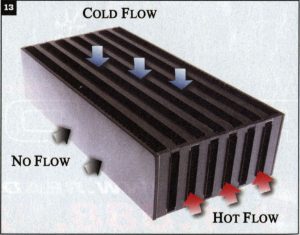
This cutaway view at an intercooler core segment is from Garrett Turbos. It shows the typical How paths through any cooler cure. The thickness of the core, the width of the flow channels and the density of the separators all affect how well any intercooler or other radiator dissipates heat.


